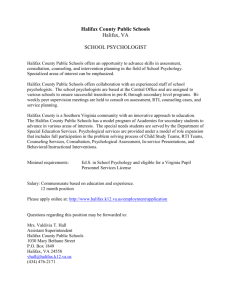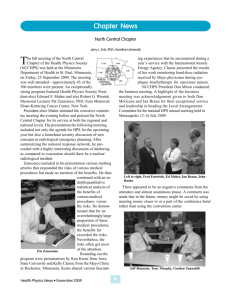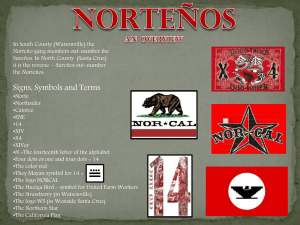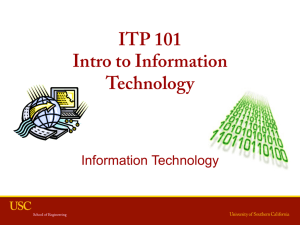Rev John Watson 2 - Warren Family History Home
advertisement
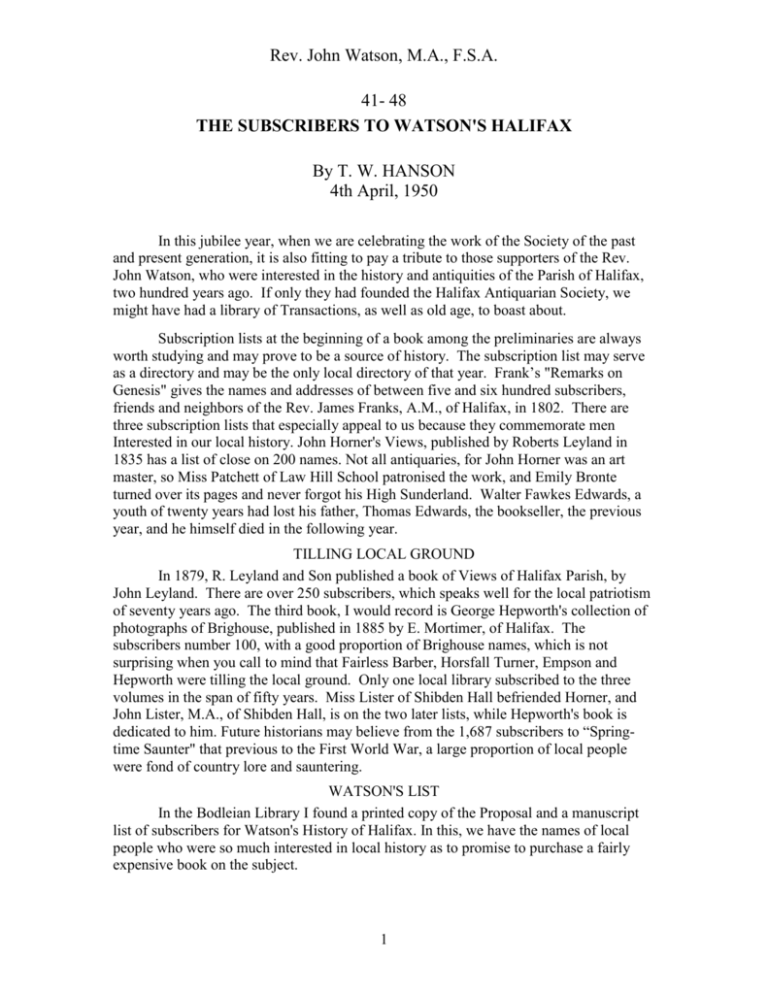
Rev. John Watson, M.A., F.S.A. 41- 48 THE SUBSCRIBERS TO WATSON'S HALIFAX By T. W. HANSON 4th April, 1950 In this jubilee year, when we are celebrating the work of the Society of the past and present generation, it is also fitting to pay a tribute to those supporters of the Rev. John Watson, who were interested in the history and antiquities of the Parish of Halifax, two hundred years ago. If only they had founded the Halifax Antiquarian Society, we might have had a library of Transactions, as well as old age, to boast about. Subscription lists at the beginning of a book among the preliminaries are always worth studying and may prove to be a source of history. The subscription list may serve as a directory and may be the only local directory of that year. Frank’s "Remarks on Genesis" gives the names and addresses of between five and six hundred subscribers, friends and neighbors of the Rev. James Franks, A.M., of Halifax, in 1802. There are three subscription lists that especially appeal to us because they commemorate men Interested in our local history. John Horner's Views, published by Roberts Leyland in 1835 has a list of close on 200 names. Not all antiquaries, for John Horner was an art master, so Miss Patchett of Law Hill School patronised the work, and Emily Bronte turned over its pages and never forgot his High Sunderland. Walter Fawkes Edwards, a youth of twenty years had lost his father, Thomas Edwards, the bookseller, the previous year, and he himself died in the following year. TILLING LOCAL GROUND In 1879, R. Leyland and Son published a book of Views of Halifax Parish, by John Leyland. There are over 250 subscribers, which speaks well for the local patriotism of seventy years ago. The third book, I would record is George Hepworth's collection of photographs of Brighouse, published in 1885 by E. Mortimer, of Halifax. The subscribers number 100, with a good proportion of Brighouse names, which is not surprising when you call to mind that Fairless Barber, Horsfall Turner, Empson and Hepworth were tilling the local ground. Only one local library subscribed to the three volumes in the span of fifty years. Miss Lister of Shibden Hall befriended Horner, and John Lister, M.A., of Shibden Hall, is on the two later lists, while Hepworth's book is dedicated to him. Future historians may believe from the 1,687 subscribers to “Springtime Saunter" that previous to the First World War, a large proportion of local people were fond of country lore and sauntering. WATSON'S LIST In the Bodleian Library I found a printed copy of the Proposal and a manuscript list of subscribers for Watson's History of Halifax. In this, we have the names of local people who were so much interested in local history as to promise to purchase a fairly expensive book on the subject. 1 Rev. John Watson, M.A., F.S.A. The Rev. John Watson came to Halifax as curate to Dr. Legh in 1750 and four years later removed to Ripponden, where he served as Perpetual Curate until 1169. He probably commenced making researches for his work while at Halifax, and continued his task- and pleasure--in the curate's house' at Ripponden. By 1760 he had accumulated sufficient material to warrant an announcement. The advertisement is dated from Ripponden, November 20, 1760. It is addressed TO THE PUBLIC, and commences: "Gentlemen,“As I propose to publish the History and Antiquities of the Parish of Halifax, I beg leave to request the favor of your assistance in carrying out so extensive and interesting a work." Watson goes on to ask for particulars of old deeds, antiquities, tradesmen's tokens, etc. He concludes his appeal with a request for subscriptions in these words: "NO MERCENARY VIEWS" .. This performance will be adorned with several copper- plates, amongst the rest with some ancient monuments in Halifax Church, and the parochial Chapel at Eland; as to the modern ones, it is hoped the heads of the families to whom they belong (as is commonly done in such cases) will be so kind as to contribute the same to the work. It will be published by subscriptions, the terms of which are fifteen shillings for one copy in sheets (the whole to be paid at the delivery thereof), however, as I have no mercenary views in undertaking this work, if the number of subscribers be so great as to exceed the expense I am at, the copies will come to less, and as in all probability there will be few or none printed for sale, it is desired that those who choose to have the book will send in their names to the publisher at his house in Ripponden or to P. Darby printer, in Halifax, and the favor will be acknowledged by their humble servant. JOHN WATSON. Halifax: Printed by P. Darby, where Printing is neatly Per- formed." It must have been Mr. Watson's intention to entrust the printing of his History to Pressic Darby, but Darby only stayed two or three years in Halifax and the volume did not appear until fifteen years later. The author failed to persuade any of the local gentry to present plates of their old homes to the book and we may well regret their parsimony. A manuscript addendum runs thus-Revd. Mr. Watson's Engagement to the Encouragers of his intended History of Halifax was that the work should be delivered to them at 15s each copy in sheets. But he publicly declared that the account of the charities was to be considered as a separate thing and sold separately at 5s each copy. Now the difference therefore which is made in the expense is but one shilling which is made up by the delivery of the copies in half binding John Watson. CONSTRUCTION OF BOOK 2 Rev. John Watson, M.A., F.S.A. This note explains the construction of the book. The History of Halifax Parish extends to p. 528. Then follows, what might be considered an appendix-" Remarks on the Dialect of Halifax Parish" (pp. 529-548). When Watson decided to add to his work "An Account of the Charitable Donations within the Vicarage of Halifax," it was placed later still (pp. 549-728) instead of moving the appendix on Dialect and it concludes with the word EXEGI. Another appendix concludes the volume "A Catalogue of Plants," pp. 729764. Charles Crossland, F.L.S. a great admirer of James Bolton wrote in our Trans8ctions (1909 p. 333) " I have sought diligently for some trace of acknowledgment as to the author- ship of the Catalogue of Plants but have found nolle. Now this was undoubtedly worked out and compiled by the labor of James Bolton." This attribution was accepted by most botanists. In July 1939, I examined a copy of Watson's Halifax that bore the bookplate of Edward Akroyd and also this note: This beautiful copy of Watson's History, in the Margins of which are copied the notes and corrections of Dr. T. D. Whitaker, the Historian of Whalley, taken from the Doctor's own copy, was presented to me by Mr. Edward Akroyd, the munificent founder of All Souls' Church, when on a visit to him in January 1862. Jas. Crossley, This copy came into the possession of the late Mr. W. B. Crump, and is now the property of Mr. Cyril Sunderland. JAMES CROSSLEY James Crossley born in 1800 at The Mount, neighbor to Bankfleld, settled in Manchester and accumulated an immense and famous library. Dr. Whitaker's notes are not complimentary at times; he dubs the Rev. John Watson "a shallow conceited Whig." At the head of p. 729 A Catalogue of Plants is the MS note . “By the Late Thomas Bolton". Dr. Whitaker, born in 1758 is a contemporary authority so we may rely on his statement. Thomas Bolton, elder brother to James lived at Pye Nest, Skircoat, and was an enthusiastic naturalist. His collection of birds' eggs was purchased by the Dowager Duchess of Portland for her museum at Welbeck. He also had extensive collections of butterflies and moths, shells and Derbyshire spars. Thomas was a good brother to James. He died in 1778. The list of subscribers 1759-00 has this preamble in Watson's handwriting: “We, whose names are hereunto subscribed, do promise to pay to the Revd. Mr. Watson of Ripponden, the sum of 15s each on his delivery to us, one copy respectively of a new History of Halifax Parish in the County of York, which he is now composing. Witness our Hands." During the fifteen or sixteen years that elapsed before the work was delivered, some subscribers died and Watson had to note their decease. The first name on the list is James Tunstall, Vicar of Rochdal6 (Dead). WATSON'S LIST 3 Rev. John Watson, M.A., F.S.A. I have taken the liberty of re- arranging the names as Watson might have done, had he printed the list in his History. First we have the titled subscribers. LORD STRANGE (dead). James, heir of the 11th Earl of Derby used the title Lord Strange, though the heirs apparent of the Lords Derby are by courtesy styled Lords Stanley. He married Lucy Smith of Weald Hall and in a letter transcribed in our Transactions, 1&22 p. 180, he signs "Smith Strange." The same paper on the Old Cock Hotel gives an idea about his interest in our district. Lord Strange as Chancellor of the Duchy of Lancaster, presented the Rev. John Watson to the Rectory of Meningsby, Lincolnshire in 1766. Lord Strange died in 1771. SIR GEORGE SAVILE (Quere). Watson was doubtful whether he had a definite promise from Sir George. His full length portrait, the baronet examining a map of the Calder Navigation, hangs in Halifax Town Hall. Sir George Savile lived until 1785. Next come the Clergy. DR. GEORGE LEGH. Vicar pf Halifax from 1731 to 1775. He died 6 December, 1775; the History was published a few months before. Rev. GEORGE BRAITHWAITE (" removed from Halifax Parish" -Watson). Curate of Rastrick 1748. He died 29 December, 1798 aged 89 and was still at Rastrick according to Horsfall Turner (H.A.S. Trans., 1908, p. 306). REV. GEORGE BURNETT. Curate of EIland from 1768 to 1793. REV. MR. FALCON ("lives in Halifax Parish "-curate of Leeds (dead)-Watson). REV. RICHARD FISHER. Curate of Sowerby Bridge from 1746. REV. MR. WADSWORTH. ("Somewhere in Hertfordshire" -Watson.) Is he the Rev. John Wadsworth of Holdsworth House? Curate of Coley 1768-1774 (Pearson's "Northowram" p. 47). DR. EDWARD WATKINSON (dead). Curate of Luddenden 1724-28, died 1767. REV. JOHN WELSH. 4 Rev. John Watson, M.A., F.S.A. Curate of Sowerby 1750. The local clergy supported the venture handsomely, perhaps more from a fraternal interest in the Rev. John Watson, than from zeal for historical research. REV. MR. CROFTS, Honley (dead). REV. MR. PEGGE, Whittington, Derby. Samuel Pegge (1704 - 1796) antiquary is in the Dictionary of National Biography. He was appointed Vicar of Heath, Whittington in 1758. In the Bodleian Library is a long letter from Watson to Pegge about Halifax Gibbet Law. He transcribes, practically word for word what Watson printed about the Gibbet in his History, so I did not copy that part of the letter. Ripponden, February 27, 1764. J. Watson to Revd. Mr. Pegge at Whittington near Chesterfield, Derbyshire. "And now to put an end to this long (& I am afraid tiresome) Letter. I must intreat You to favor me with some Remarks upon it, for every Hint is of service in leading me nearer to the right understanding of this dark Subject. And I must also beg that You will give me Leave now & then to trouble you with a Letter for I have no man of Learning to converse with here & I should esteem it a singular Happiness to have your Advice in different Cases, & in return if I have any Books which you have Dot, I should be glad to send you such Transcripts out of them as will be serviceable." Rev. HENRY RICHARDSON, Thornton in Craven. Rev. Mr. SYKES. Vicar of Brad- ford. Rev. Mr. TILLOTSON. of Lon- don (dead). ' Rev. JAMES TUNSTALL (dead), Vicar of Rochdale 1757-62. Dr. WRAY, Vicar of Rochdale, 1762-78. Rev. Mr. WHEELER, of Dewsbury (dead). Rev. Mr. ZOUCH, Sandal, near Wakefield, Vicar from 1754 to 1789. Thirdly, A LIST OF THE GENTRY R. ALLINSON (dead). THOMAS ASTLE, Lambeth. B. BARTLETT, junr., London, F .S.A., formerly of Bradford. See Dict. Nat. Biog. 5 Rev. John Watson, M.A., F.S.A. THOS. BAYLEY. Hope, near Manchester. DANIEL BENTLEY, of Cross- land (dead). THOS. BIRCH, of Ardwick. Watson was private tutor to the three sons of Samuel Birch, of Ardwick, 174S-50. GODFREY BOSVlLE, of Gunthwaite. JAMES BRADSHAW, Manchester. JOSEPH BREAR, Luddenden. MUSGRAVE BRISCOE, Wakefield. WILLIAM BGOADBENT, Sowerby. JAMES CARR, Attorney, Halifax. DANIEL DYSON, Ripponden. ELY DYSON. HENRY DYSON, Ripponden. JOS. EDMONDSON, Mowbray Herald. See Dict. Nat. Biog. Toseph Edmondson was a coach-painter who specialized in emblazoning coat-armour on carriages. In March, 1764, he was appointed Mowbray Herald extra- ordinary, continued the coach- painting business. Most of the peers had their genealogies drawn up or rearranged by him. Died 1786. JOHN EDWARDS, Willow Hall. JOHN FIRTH, Alderman of Leeds. RICHD. FRANK, Pontefract (dead). WILLIAM GREAME (dead). Died May 27, 1766. JOHN GREENWOOD, Sowerby Street. NATHANIEL HOLDEN (dead). ELKANAH HOLROYD, near Halifax. JER. HOLROYD, Kebroyd. JOSHUA HORTON, Howroyd (1720-1793). MARY HORTON, junr. (dead). Died June, 1769. WILLIAM HORTON, Chadderton (dead). Created Sir William, January 22,1764, died February 25, 1774. JAMES HOYLE of Royde, Ripponden. JOSHUA HUDSON (dead). CYRIL JACKSON, M.D., Stamford. Dr. Jackson was living in Halifax in 1755 when his son, Cyril Jackson, entered Manchester Grammar School; he became the famous Dean of Christ Church. In 1762, when his son William entered the school, Dr. Jackson was living at Stamford. 6 Rev. John Watson, M.A., F.S.A. JOSHUA LAYCOCK, near Halifax. JOHN LISTER (dead), "deliver this to Mr. Samuel Lister "- (Watson). THOMAS MILNES. near Halifax. HENRY PICKERING, Cartmell (dead). Mr. POLLARD, Halifax. Mr. PRIESTLEY, White Windows. ROBT. RADCLIFFE, Foxdenton, Lancs. THOMAS RAMSDEN, Halifax. CHRISTOPHER RAWSON, near Halifax. JOHN RICHARDSON, Kildwick. RICHARD RICHARDSON, North Bierley. WILLIAM RICHARDSON, M.D., Ripon. JER. ROYDS, of Bucklersbury, London. JOHN SMEATON, F.R.S., near Leeds. Smeaton came from the building of Eddystone Lighthouse to survey the Calder and Hebble Canal, arriving in Halifax October 21, 1757. He made a Plan of Halifax in 1760 or 1761 for a piped water supply. Watson, caused a ground plan to be taken of this town" in 1759 for his History. Smeaton may have been the surveyor. JOHN SMITH, Bradford (dead). DAVID STANSFELD (dead), Died August 10, 1769. GEORGE STANSFELD, near Halifax JOHN THOMAS (dead). RICHARD TOWNLEY, Belfield. JAMES WADDINGTON. JOHN WATERHOUSE, Halifax. THOMAS WILKINSON (dead). JOHN WILSON, Broomhead. 7 Rev. John Watson, M.A., F.S.A. Six dozen subscribers to a local history that cost a guinea, a golden guinea, and weighed in a balance is a good record, and there were sufficient local subscribers to have formed an Antiquarian Society, although the Rev. John Watson complained, Elijah-like, “I have no man of learning to converse with, here”. I wonder how many subscribers read the tome through from end to end for you find so many copies in mint condition, not thumbed nor dog-eared. After all, it is a reference book, not a narrative history, certainly not a bed- side, book nor to be taken up to pleasantly wile away a leisure hour. For that purpose, I recommend re-reading past volumes of our Transactions or Oliver Heywood's Diaries. I have a copy of Watson with White Windows associations. John Priestley, an original subscriber (1718-1792) left the silken book-marker in pp. 298-99 where the Priestley pedigree is printed, and it is still there. John Priestley was a Governor of Heath Grammar and has marked several paragraphs relating to the Duties of the Governors-and the Master. A LETTER FROM THE REV. JOHN WATSON TO MR. VALENTINE STEAD. Sir, - As you told me you would be glad of any assistance relating to the Watercourse at Halifax I trouble you with the following. Translation of part of Mr. Nalson's MS., Fol. 334. Parcell of the Possessions of Tho. Cromwell, late Earl of Essex, attainted and first parcell of the Possessions of the late Monastery of Lewis (sic) in Sussex. Halifax with its members in the County of York, Concerning the farming of the Manor there with all Messuages, Lands, Tenem'ts, Meadows, Woods pastures, Rents. Fines, Reliefs, Escheats, Forfeitures, Perquisites of Court, Fee Farms and all other Issues, profits, Emoluments and Commodities whatsoever within the VilIs of Halifax, Heptonstall, Conisborough, Braywell, Sandal, Harthill, Donington and Tronefleet in the County of York with all their appurtenances and Free Rents, viz., in Eland 4s., Hipperholme 3d., Shelf 6d., North'm 6d., and Ovenden 6d., as they are let to Robt. Waterhouse by Indenture dated under the Common Seal of the late Monastery of Lewis, dated June 3d., 26 Henry VIII, for Term as in the said Indenture is more fully contained Paying yearly' for the same £16 14s., besides 21s. 6d. of an annual payment called The Tythe or Tenth lately received by a Farmer there for our Lord the King as in his Demesn of Wakefield and lately in the Hands of our Lord the King and extinct. LADY ANNE CLEVE These premises (as appear by the said MS., which You may consult) were granted to the Lady Ann Cleve for the term of her Life by the King's Letters Patents without anything paying for the same. The Exceptions in the Grant to the said Lady Ann were the above £24 68 of Tythe which still remained in the King's Hands; also in Halifax and other members of the same in Spiritualities to the yearly value of £95 6s. 8d. farmed to John Waterhouse and others by Indenture under the Convent Seal of the Monastery of Lewis; also the Benefices of Conisborough, Braywell, Sandal, Harthill, Donington, and Halifax, the right of presenting to which remained in the King. 8 Rev. John Watson, M.A., F.S.A. This plainly proves that the Lady Ann Clive was never Lady of the Manor of Halifax. Your MS. Only sais Curia Dom: Ann Cleve, not Dom: Maneni de Halifax, as would necessarily have been the Case had the Fee been in Her, likewise there is an Expression in it to this purpose that the Water- course arises in the Ground of the Lord which can be no other than King Hen. 8, under whom the Lady Ann held the Court by Patent as is there plainly expressed. Now if the Ground where the spring rises did once belong to Hen. 8th as Lord, to whom must it now belong but to the Duke of Leedes as Lord, except it has since been alienated, which Mr. Marsden may find out if He will search the Records of the Office; however, at all Events I think your Information must come out of the Duke's Court for I cannot see how the Business transacted in Lord Irwyn's Court can have any connection with what You are desirous to discover. If anything falls in my way which I judge will be of service to the laudable Scheme You are pursuing, You may depend upon its being communicated without loss of Time by Sir, Your very Hum: Servt., J. WATSON. P.S.-Will Harrison gave by Will dated May 11th, 1618, towards the bringing Water to Halifax in Lead, ten pounds, a third part at beginning, another third part at middle, and the other at finishing thereof. See Halifax Register Ao. 1618. VALENTINE STEAD The letter is addressed .. For Mr. Val. Stead in Halifax." It is not dated but as it was evidently sent from Ripponden, it was written after 1754 and before 1758, as Mr. Stead died in that year. Watson's handwriting is small and neat, his quotations are in a smaller script and more upright than his usual style. Valentine Stead built one of the earliest brick buildings in Halifax. That was in 1730 and formed two houses on the south side of the High Street (see Hx. Antq. Socy. Trans., 1930). Watson, referring to Valentine Stead, wrote .. whose sudden death deprived us of the benefit of many valuable papers, relating to the charities in this parish." This particular letter refers to a question raised during the preliminary negotiations for an Act of Parliament for supplying the Town of Halifax with Water. The Act is dated 1762. Watson was never quite clear about the manorial rights for the township of Halifax. Who could decide about the watercourses-Lord Irwin's court of the rectorial manor of the township or the Wakefield Manor Court of the Duke of Leeds? In Watson's day, there were no printed extracts from the Wakefield or the Halifax Court Rolls to help him. He favors Valentine Stead with an abstract of a grant to Anne of Cleves. The Queen's connection with our township is detailed in J. Lister's Life of Dr. Holdsworth (Hx. Antq. Socy. Trans.1907). Trunfleet, five miles north of Doncaster; was part of the Conisborough territory of the Warrens and the Priory of Lewes. In his History (p. 101) Watson records it as Townefleete. This letter from the Rev. John Watson to Valentine Stead represents an activity that he thought was a duty that antiquaries should follow. In the Dedication to the Inhabitants of the Parish of Halifax he said he would be 9 Rev. John Watson, M.A., F.S.A. Happy, if any Thing I have discovered will contribute to the clearing up those Difficulties which have so frequently embarrassed'\ your Neighborhood and given Rise to disagreeable Litigations! Happy. . . that I had been the lucky Instrument of spreading Amity and Good-will amongst you. THE Society OF ANTIQUARIES AND THE REV. JOHN WATSON, M.A., F.S.A. A. PORRITT 10 Rev. John Watson, M.A., F.S.A. THE SOCIETY OF ANTIQUARIES AND THE REV. JOHN WATSON, MA., FSA. I have combined the subjects of this Paper, I think with advantage, so closely are they linked: dealt with separately each would require the other to supplement it. Both having been active during the same century their association was an important factor. Indeed it was the Reverend John Watson who introduced the 1717 London SOCIETY OF ANTIQUARIES to 1775 Halifax in his volume “THE HISTORY AND ANTIQUITIES OF HALIFAX”. His own explanation gives us the precise origin and objects of the Society, and will be here quoted. When the population of the old Parish of Halifax was less than a tenth of the present number of inhabitants it is unlikely that very many residents would be historically-minded. And in 1750 especially, when at the age of 26 John Watson came to Halifax as Curate to Vicar Legh at the Parish Church, there would be no expectation that before a quarter- century had passed John Watson’s name, like the antiquarian work on which he became engaged in the succeeding years, would have become almost imperishable! We may well ask what made him undertake the extensive research and work involved that led to that momentous volume of more than eight hundred substantial pages: “The History & Antiquities of Halifax”? He was not a native of Yorkshire, but of Cheshire - born at Prestbury in 1724, the son of Legh Watson. Grammar Schools at Eccles, Wigan and Manchester provided his education prior to his entering Brasenose College, Oxford. There he became B.A. at twenty-one and M.A. when twenty-four, the year he was ordained by the Bishop of Chester. He had held Curacies at Runcorn and Wigan before coming to Halifax. John Watson’s Parish Church Curacy lasted less than five years; while here, however, and during his ensuing sixteen years at Ripponden at St. Bartholomew’s Church, his active local interest and valuable research and study gained for him wide knowledge of this area of Yorkshire’s natural features and history - information that was to be recorded for the Society of Antiquaries in due time. His first year at Ripponden, 1754, had for John Watson personal trouble involving him in rebuilding his house - “partially reduced to ashes,” It was reported, at his own 11 Rev. John Watson, M.A., F.S.A. cost, said to be £400 - a goodly sum three centuries ago. While there, too, his twentythree years’ old wife, Susannah, a daughter of the Vicar of Sandbach, died after only three years in Ripponden. In 1761 John Watson re-married, in Elland, Ann, a daughter of James Jaques; and nine years later he left Ripponden and became Rector of Stockport - where he remained until his death in 1783, when in his fifty-ninth year. Thus it would seem that during his twenty years in Yorkshire John Watson acquired the mass of material his research produced that finally came to us in his book, “The History and Antiquities of Halifax”, published in that year 1775 by T. Lowndes, of Fleet Street, London. As if anticipating the obvious question as to why he undertook those years’ research and labor that led finally to his “History” of the area John Watson answers it himself, in which he terms his “Dedication” of the volume; and there could be no more reliable guide for the Society of Antiquaries than he proved to be. He had been elected a Fellow of the Society in 1759, he tells us, at the invitation of the President, Lord Willoughby of Parham, while at Ripponden. The Society of Antiquaries, he explains, required that a competent and knowledgeable member in each part of the country should study and in due time compile a history of that area - preferably his own locality - from the earliest times. by this means gradually the entire country would come to have its antiquities and its history recorded in printed volume form. This far-seeing treatment of the nation-wide problem, we can agree, was a most productive project, with widespread beneficial results. More than two centuries later its results are with us nation-wide. John Watson assures us that for his part he spared neither labor nor pence in searching every repository where anything relating to his subject was likely to be found. No easy task in those times! His contribution in the form of that “History” of his has held its prime place on library and private shelves for the past two centuries. Accuracy of information given prompted him to report that “the part that he presented to the public is an account of a district but little known, till of late it became so much distinguished by its trade; but as it is rising so rapidly from its obscurity description can neither be deemed needless nor unreasonable.” (A timely glimpse for us of local conditions as John Watson found them!) Although the Society of Antiquaries formally dates from 1717, it seems that in 1707 “a group of men with antiquarian tastes” met weekly at “The Bear” tavern in the Strand. Other taverns in Fleet Street were meeting places, too; but in 1717 the Society was formally constituted, with one Peter le Neve, who had presided from the 1707 outset, as President of the Society of Antiquaries in 1717, with William Stukely as Secretary. Offices of Director/Secretary were also duly appointed. In 1751 the Society obtained its Royal Charter from King George II - who assumed the titles of “the Society’s Founder and Patron”. In 1767 a Supplemental Charter was granted by George II, giving the society wider powers than it had held formerly. The Society’s first “Minutes” concerned a Meeting in February, 1717, when members were limited in number to one hundred. They had originally met at the “Mitre” tavern in Fleet Street, but in 1726 they moved to apartments in Gray’s Inn. Their next move was to a meeting-house in Chancery Lane, in 1773 a successful change that brought increased development. Thirty years later the Society was granted quarters at the then newly-built Somerset House: and they were there almost a century, finally moving 12 Rev. John Watson, M.A., F.S.A. into their apartments at Burlington House in 1875 - still their “home” after more than a further century. Room needed existed, and there the accumulations of the further century have been housed. The expanding library alone, declared to total upwards from a total of a hundred and thirty thousand books and periodicals, is a massive possession. Their first library purchase had been made in 1719. The Society, having wide interests in the antiquary and archaeological worlds, possesses many items for exhibition and study in its rooms - gifts or bequests from Fellows or other sources. From its early years the society has been active in publication of antiquarian research. One important feature that began in 1770 was a continuing series of large volumes entitled “Archaeologia” (of which the Halifax Antiquarian Society library has copies of the first fifty volumes.) They comprise apart from society information reports of the many Letters or Tracts received from Fellows following research conducted in their own localities for the purpose explained above by John Watson: they are termed “Miscellaneous Tracts related to Antiquity.” In the first volume of” Archaeologia” are two of John Watson’s contributions of which parts are here repeated. This apart, as a note of interest, the first recorded Letter in the initial “ Archaeologia” volume of the series relates to the “antiquity and use of Beacons”, which was read on April 13th, 1749, while the Society was still at Gray’s Inn. It has to be remembered that John Watson was himself a Fellow of the Society of Antiquaries since 1759 - at the invitation of the then President, Lord Willoughby, while Watson was at Ripponden, he tells us in his “History”. John Watson wrote a Letter to the Society telling of his discovery of the Roman Statium of Coccium in Lancashire - “quite unknown”, he says, “to antiquaries hitherto.” This, like another of his Letters, is quoted, too, in the “Archaeologia” referred to: it was written on November 24th, 1761, from Ripponden. And another Letter from him, also recorded, dealing with Roman Stations “recently discovered on the borders of Yorkshire”, was read to the Society on February 20th 1766. In 1771 Watson’s discovery of widely diverse Druidical Remains - which are given a full-page illustration in his “History” - prompted a special Letter on that subject, too, which is recorded in the second “Archaeologia” volume. Interesting it is, I think, especially, to find recorded another Letter which indicates that John Watson had a companion in certain of his research and study of the locality for the Society. This was a Letter that had been written by Thomas Percival on July 8th, 1760. An extract from it relates to Roman Roads. “Mr. Watson and myself, “it reads, “have traced the Roman Way from Manchester into Yorkshire; and we find that the road goes directly to Kirklees, and this, or rather Clifton, must be the “Cambodunum” of the ancients; the Roman Camp in between Clifton and Kirklees, but I suppose the town to have been at Clifton.” Shades of the “M63” 2~ centuries later! Subsequent antiquaries, it now seems likely, would not accept their “Cambodunum” and their supposition: But a map of the area would place their believed site not a long way from the later assumed one. 13 Rev. John Watson, M.A., F.S.A. Being a correspondent who reported results of his research to the Society John Watson’s name is included in the “Home Members” Index in the first of the “Archaeologia” volumes. Regarding John Watson personally I am reminded that he is depicted in his “History” frontispiece as a rotund, round-faced cleric; and a local citizen of the time who knew the industrious antiquary well wrote of him: “The Velvet Cap in which he sat at work in his study is now in my possession. When Watson donned it, woe to the profane, whether of his household or not, who intruded.” The artist of this picture, “W. Williams”, was one so named who was a tutor of John Homer, one of Halifax’s most celebrated artists. Of interest, too, is the fact that John Watson was reporting to the Society on his research fourteen years before his “History” was published; and he died only eight years later, in 1783, while still at Stockport. Among the Society of Antiquaries’ collections and other special items were some publications besides those already mentioned. Their former “Proceedings” begun in 1849, was replaced in 1921 by the Society’s” Antiquaries’ Journal”. Heraldry has its place in the Society, and volumes of “Aspilogia” or Materials of heraldry have been printed by the Society. In the world of Art it possesses many oil paintings, brass rubbings of all monumental brasses known in the British Isles; a collection of more than 3,000 Broadsides and proclamations acquired in 1756, dating from the reigns of Edward IV to James I; 12th century manuscripts, several hundred early printed books (1500-1641); a collection of over ten thousand seals and impressions, and many other treasures. A very early achievement was the issue of volumes of engravings and descriptions of antiquities, manuscripts and monuments, mostly printed between 1718 and 1835. Omitting various other attributes and possessions, this is a record of a remarkable assembly of treasured possessions that present London’s Society of Antiquaries as a veritable museum - albeit a very active antiquarian one! At times over the years certain Halifax Antiquarian Society members have spent and have enjoyed appreciated periods as Fellows of the Society of Antiquaries - as is the case in its present 278th year of activity. A. Porritt. REFERENCES: 14 Rev. John Watson, M.A., F.S.A. C. F. Stell, M.A., B.Arch., A.R.IB.A., F.S.A., and D. Haigh, M.A., F.S.A., are members of Halifax Antiquarian Society - Ed. John Watson’s 1775. “History & Antiqul.Sies of Halifax.” Short Guide to S. of A. Notes (per D. Haigh). H.A.S. 1958. Portrait from The Memoirs of the Ancient Earls of Warren and Surrey 15

